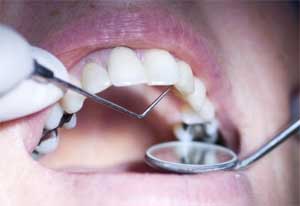- Home
- Editorial
- News
- Practice Guidelines
- Anesthesiology Guidelines
- Cancer Guidelines
- Cardiac Sciences Guidelines
- Critical Care Guidelines
- Dentistry Guidelines
- Dermatology Guidelines
- Diabetes and Endo Guidelines
- Diagnostics Guidelines
- ENT Guidelines
- Featured Practice Guidelines
- Gastroenterology Guidelines
- Geriatrics Guidelines
- Medicine Guidelines
- Nephrology Guidelines
- Neurosciences Guidelines
- Obs and Gynae Guidelines
- Ophthalmology Guidelines
- Orthopaedics Guidelines
- Paediatrics Guidelines
- Psychiatry Guidelines
- Pulmonology Guidelines
- Radiology Guidelines
- Surgery Guidelines
- Urology Guidelines
Nonrestorative treatments for carious lesions: ADA Guidelines

American Dental Association has released its guidelines on nonrestorative treatments for carious lesions.The guidelines have been published in The Journal of American Dental Association.
An expert panel convened by the American Dental Association Council on Scientific Affairs and the Center for Evidence-Based Dentistry conducted a systematic review and formulated evidence-based clinical recommendations for the arrest or reversal of noncavitated and cavitated dental caries using nonrestorative treatments in children and adults.Although the recommended interventions are often used for caries prevention, or in conjunction with restorative treatment options, these approaches have shown to be effective in arresting or reversing carious lesions.
Dental caries is a chronic noncommunicable disease that affects people of all ages worldwide.Caries is caused by frequent acid production from the metabolism of dietary carbohydrates. This mechanism results in the emergence of acid-producing and acid-tolerant organisms in supragingival oral biofilms, altered pH, shift in the demineralization-remineralization equilibrium, and loss of tooth minerals.
Major Recommendations-
To arrest cavitated coronal carious lesions on primary or permanent teeth, should we recommend silver diamine fluoride, silver nitrate, or sealants?
To arrest advanced cavitated carious lesions on any coronal surface of primary teeth, the expert panel recommends clinicians prioritize the use of 38% SDF solution (biannual application) over 5% NaF varnish (application once per week for 3 weeks). (Moderate-certainty evidence, strong recommendation.)
To arrest advanced cavitated carious lesions on any coronal surface of permanent teeth, the expert panel suggests clinicians prioritize the use of 38% SDF solution (biannual application) over 5% NaF varnish (application once per week for 3 weeks). (Low-certainty evidence, conditional recommendation.)
To arrest or reverse noncavitated coronal carious lesions on primary or permanent teeth, should we recommend NaF, stannous fluoride, acidulated phosphate fluoride (APF), difluorsilane, ammonium fluoride, polyols, chlorhexidine, calcium phosphate, amorphous calcium phosphate (ACP), casein phosphopeptide (CPP)–ACP, nano-hydroxyapatite, tricalcium phosphate, or prebiotics with or without 1.5% arginine, probiotics, SDF, silver nitrate, lasers, resin infiltration, sealants, sodium bicarbonate, calcium hydroxide, or carbamide peroxide?
To arrest or reverse noncavitated carious lesions on occlusal surfaces of primary teeth, the expert panel recommends clinicians prioritize the use of sealants plus 5% NaF varnish (application every 3-6 months) or sealants alone over 5% NaF varnish alone (application every 3-6 months), 1.23% APF gel (application every 3-6 months), resin infiltration plus 5% NaF varnish (application every 3-6 months), or 0.2% NaF mouthrinse (once per week). (Moderate-certainty evidence, strong recommendation.)
To arrest or reverse noncavitated carious lesions on occlusal surfaces of permanent teeth, the expert panel recommends clinicians prioritize the use of sealants plus 5% NaF varnish (application every 3-6 months) or sealants alone over 5% NaF varnish alone (application every 3-6 months), 1.23% APF gel (application every 3-6 months), or 0.2% NaF mouthrinse (once per week). (Moderate-certainty evidence, strong recommendation.)
Noncavitated Lesions on Approximal Surfaces
- To arrest or reverse noncavitated carious lesions on approximal surfaces of primary and permanent teeth, the expert panel suggests clinicians use 5% NaF varnish (application every 3-6 months), resin infiltration alone, resin infiltration plus 5% NaF varnish (application every 3-6 months), or sealants alone. (Low- to very-low-certainty evidence, conditional recommendation.)
Noncavitated Lesions on Facial or Lingual Surfaces
- To arrest or reverse noncavitated carious lesions on facial or lingual surfaces of primary and permanent teeth, the expert panel suggests clinicians use 1.23% APF gel (application every 3-6 months) or 5% NaF varnish (application every 3-6 months). (Moderate- to low-certainty evidence, conditional recommendation.)
Noncavitated Lesions on Any Coronal Tooth Surface
- To arrest or reverse noncavitated carious lesions on coronal surfaces of primary and permanent teeth, the expert panel suggests clinicians do not use 10% CPP-ACP if other fluoride interventions, sealants, or resin infiltration is accessible. (Low-certainty evidence, conditional recommendation.)
To arrest cavitated root carious lesions or arrest or reverse noncavitated root carious lesions on permanent teeth, should we recommend NaF, stannous fluoride, APF, difluorsilane, ammonium fluoride, polyols, chlorhexidine, calcium phosphate, ACP, CPP-ACP, nano-hydroxyapatite, tricalcium phosphate, or prebiotics with or without 1.5% arginine, probiotics, SDF, silver nitrate, lasers, resin infiltration, sealants, sodium bicarbonate, calcium hydroxide, or carbamide peroxide?
- To arrest or reverse noncavitated and cavitated carious lesions on root surfaces of permanent teeth, the expert panel suggests clinicians prioritize the use of 5,000 ppm fluoride (1.1% NaF) toothpaste or gel (at least once per day) over 5% NaF varnish (application every 3-6 months), 38% SDF plus potassium iodide solution (annual application), 38% SDF solution (annual application), or 1% chlorhexidine plus 1% thymol varnish (application every 3-6 months). (Low-certainty evidence, conditional recommendation.)
For Further reference log on to :
DOI: https://doi.org/10.1016/j.adaj.2018.07.002

Disclaimer: This site is primarily intended for healthcare professionals. Any content/information on this website does not replace the advice of medical and/or health professionals and should not be construed as medical/diagnostic advice/endorsement or prescription. Use of this site is subject to our terms of use, privacy policy, advertisement policy. © 2020 Minerva Medical Treatment Pvt Ltd